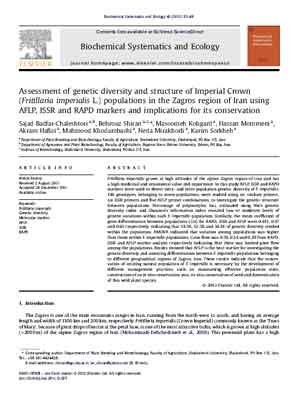NEWS 2012
Assessment of genetic diversity and structure of Imperial Crown (Fritillaria imperialis L.) populations in the Zagros region of Iran using AFLP, ISSR and RAPD markers and implications for its conservation
Sajad BADFAR-CHALESHTORI ¹ ², Behrouz SHIRAN ¹ ³, Masoomeh KOHGARD¹, Hassan MOMMENIA, Akram HAFIZI¹, Mahmood KHODAMBASHI¹, Neda MIRAKHORLI¹, Karim SORKHEH¹
Biochemical Systematics and Ecology 42: 35-48 (2012)
doi: 10.1016/j.bse.2011.12.027
¹Department of Plant Breeding and Biotechnology, Faculty of Agriculture, Shahrekord University, Shahrekord, PO Box 115, Iran
²Department of Agronomy and Plant Biotechnology, Faculty of Agriculture, Payame Nor-e-Tehran University, Tehran, PO Box, Iran
³Institute of Biotechnology, Shahrekord University, Shahrekord, PO Box 115, Iran
Abstract
Fritillaria imperialis grows at high altitudes of the alpine Zagros region of Iran and has a high medicinal and ornamental value and importance. In this study AFLP, ISSR and RAPD markers were used to detect intra- and inter-population genetic diversity of F. imperialis. 140 genotypes, belonging to seven populations, were studied using six random primers, six ISSR primers and five AFLP primer combinations, to investigate the genetic structure between populations. Percentage of polymorphic loci, estimated using Nei’s genetic diversity index and Shannon’s information index revealed low or moderate levels of genetic variations within each F. imperialis population. Similarly, the mean coefficient of gene differentiation between populations (Gst) for RAPD, ISSR and AFLP were 0.415, 0.47 and 0.63 respectively, indicating that 58.5%, 52.3% and 36.1% of genetic diversity resided within the population. AMOVA indicated that variation among populations was higher than those within F. imperialis populations. Gene flow was 0.70, 0.54 and 0.29 from RAPD, ISSR and AFLP marker analysis respectively indicating that there was limited gene flow among the populations. Results showed that AFLP is the best marker for investigating the genetic diversity and assessing differentiation between F. imperialis populations belonging to different geographical regions of Zagros, Iran. These results indicate that the conservation of existing natural population of F. imperialis is necessary by the development of different management practices such as: maintaining effective population sizes, construction of an in situ conservation area, ex situ conservation of seed and domestication of this wild plant species.

